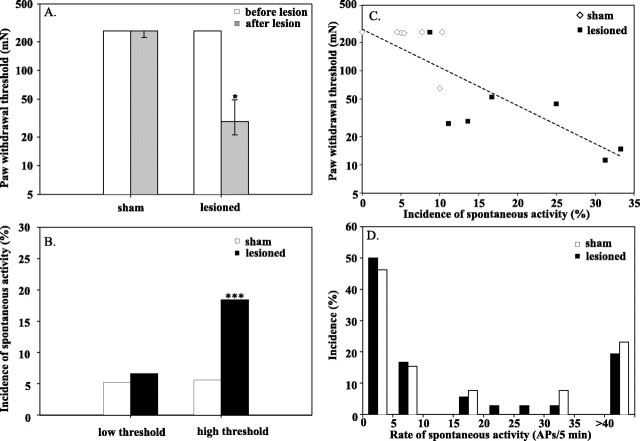Fig. 3.
Ventral rhizotomy produces mechanical hyperalgesia on the side ipsilateral to the lesion and spontaneous activity in C-fibers. A, Mechanical withdrawal thresholds decreased after the lesion but not after the sham surgery. Measurements were made before (open bars) and 7 d after (filled bars) the surgery (*p< 0.05; Wilcoxon matched pairs test). B, Incidence of spontaneous activity in high-threshold C-fibers increases after the L5 ventral rhizotomy (***p < 0.001; χ2test). The proportion of low-threshold fibers with spontaneous activity that responded to gentle brushing of the skin did not change with the lesion. However, the proportion of high-threshold fibers with spontaneous activity that did not respond to gentle brushing of the skin significantly increased after the lesion. C, Hyperalgesia is associated with a high incidence of spontaneous activity. The paw-withdrawal threshold for each animal is plotted as a function of the incidence of spontaneous activity in high-threshold C-fiber afferents for that animal. Animals with low paw-withdrawal thresholds had a higher incidence of spontaneous activity in high-threshold C-fiber afferents. Open symbolscorrespond to sham-operated animals, and filled symbolscorrespond to lesioned animals. D, Distribution of discharge frequencies for the high-threshold, C-fiber afferents. The distribution for the lesioned animals (filled bars) was similar to the distribution for the sham-operated animals (open bars). Data are normalized by the total number of spontaneously active, high-threshold afferents (n = 36, lesioned; n = 13, sham). The experimenters were blinded to the type of surgery at the time of the behavioral and electrophysiological measurements. Seven sham-operated animals and seven lesioned animals were studied.

